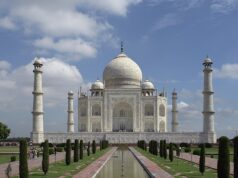Sikhism is the fifth most popular religion in the world. Punjab, India’s northernmost state, was the starting point. Sikhism was founded in the 15th century by Guru Nanak Dev Ji, the first Sikh Guru. The Bhagti Movement began in Punjab after that. Guru Nanak Dev Ji preached that there is only ONE God and He is not divided into any religion. There are ten Sikh Gurus, that’s what we’re going to tell about next.
Who are the 10 Sikh Gurus in Sikhism?
- Guru Nanak is the founder of the Sikh faith. He was born in the Talwandi city of Pakistan. He preached about the Creator’s Oneness. Because the Divine dwelled within everyone, there was no distinction between people based on caste, creed, or gender. From this, Guru Nanak emerged with a profound understanding of truth, divinity, and human existence. He wrote down his vision in hymns, which became known as “Japji Sahib.”
- Guru Angad Dev Ji was the second Guru of the Sikhs. His birthplace was Sarai Matta. Guru Angad continued to preach Guru Nanak’s teachings. He discovered the Punjabi script Gurmukhi, which means “from the Guru’s mouth”.
- The third Sikh Guru is Guru Amar Das Ji. He was born in the Indian city of Basarke. He proceeded to spread and expand the Gurus’ teachings. He wrote the Anand Sahib, or Bliss Hymns, which is one of the five daily prayers for those who have taken Amrit. In several regions, Guru Amar Das established langar or community meals.
- The fourth Sikh Guru is Guru Ram Das Ji. He was born in the Pakistani city of Lahore. Guru Ram Das, like the previous Sikh Gurus, had mystical visions. He begins the Sikh wedding ceremony, Lavaan. Guru Ram Das established the city of Amritsar and began construction on the Harimandir Sahib, also known as the Golden Temple, the Sikhs’ most important temple. He designed the Harimandir Sahib to have four doorways, one on each side of the structure, allowing people of all castes, backgrounds, languages, and religions to enter.
- Guru Arjan Dev Ji is the fifth Guru of the Sikh faith. Guru Ram Das’s youngest son. He was born in the Indian city of Goindwal. Guru Arjan was also the creator of the Adi Granth, which was known as Sri Guru Granth Sahib.
- Guru Hargobind Ji was the sixth Guru of the Sikhs. He was born in the Indian town of Wadali. Guru Hargobind established the Sikh martial style known as Gatka. Guru Hargobind also created the Akal Takhat and fought many fights throughout his life to safeguard the fundamental human rights of the people of his period.
- The seventh Sikh Guru is Guru Har Rai Ji. His great-grandfather was Guru Hargobind Ji. The “tender-hearted” Guru is his moniker. Guru Har Rai was a wonderful herbalist and healer. He was well-known for his use of natural medicine, and he had his own herbal garden where he produced his cures.
- Guru Har Krishan Ji is the eighth Guru of the Sikhs. He became Guru at the age of five and died at the age of eight in New Delhi, India, where the Bangala Sahib Gurdwara was founded. He was born in the Indian city of Kiratpur.
- Guru Tegh Bahadur Ji is the ninth guru of the Sikh religion. He was born in the city of Amritsar. In GRANTH SAHIB, he contributed several hymns. He was referred to as “Hind Di Chadar.” He gave his life to uphold the Dharma’s rights in society. Guru Tegh Bahadur was beheaded in Chandni Chowk, Delhi, on November 11, 1675. At Chandni Chowk, Gurdwara Sis Ganj Sahib was built on the site where Guru Tegh Bahadur was executed.
- Guru Gobind Singh Ji is the tenth and last guru of the Sikh religion. He was born in the city of Patna. He is a formidable warrior. On Baisakhi Day in 1699, Guru Ji established the Khalsa tradition. While fighting against the injustice of the Mughal rulers of the time, the guru and his family were martyred by the Mughal emperors.
Golden Temple

The Golden Temple is Sikhism’s most spiritually significant site. Guru Ram Das, the fourth Sikh Guru, completed the temple site in Amritsar in 1577, and it is also known as Guru Da Chakk. The Golden Temple has four doors available to individuals of all religions. It is a langar-free Sikh communal kitchen that provides all visitors with a simple vegetarian supper.
KHALSA
In 1699, Guru Gobind Singh Ji, the tenth Guru of the Sikhs, in Anandpur, gave the Sikhs a distinct identity on that day. Guru Gobind Singh appeared before his people, brandished a naked sword, and demanded, “Ahead!” He repeated his request till five Sikhs responded. These five people hailed from various castes and different locations in India. On that historic day, Guru Gobind Singh conferred a new discipline on his Sikhs, and it was to these five that Guru Gobind Singh awarded it. These five were initiated into the Khalsa’s new order by the Guru. The 5 Ks are five physical symbols worn by Sikhs who have been initiated into the Khalsa. They represent a commitment to a life of devotion and submission to the Guru by the Sikh who wears them:
- Kesh
- Kara
- Kanga
- Kachera
- Kirpan
GURU GRANTH SAHIB
Guru Granth Sahib Ji, the holy book of the Sikhs. Guru Nanak, Guru Angad, Guru Amar Das, Guru Ram Das, Guru Arjan, and Guru Tegh Bahadur are among the six Sikh gurus who contributed to the Guru Granth Sahib hyums. Non-Sikh Saints Bhagat Ravidas ji, Kabir, Namdev, and Sheikh Farid are among them. There are 1,430 angs (pages) and 5,894 shabads in the text (words). It’s spelled out in Gurmukhi script.





















